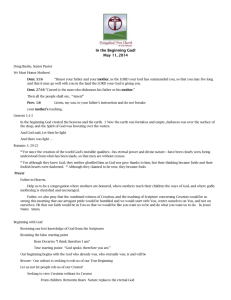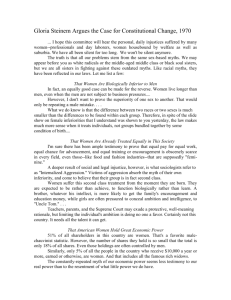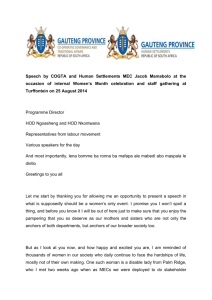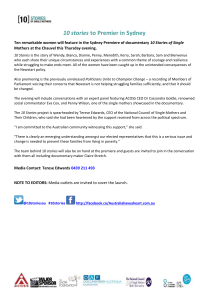III. Monitoring and evaluation for featured program (one
advertisement
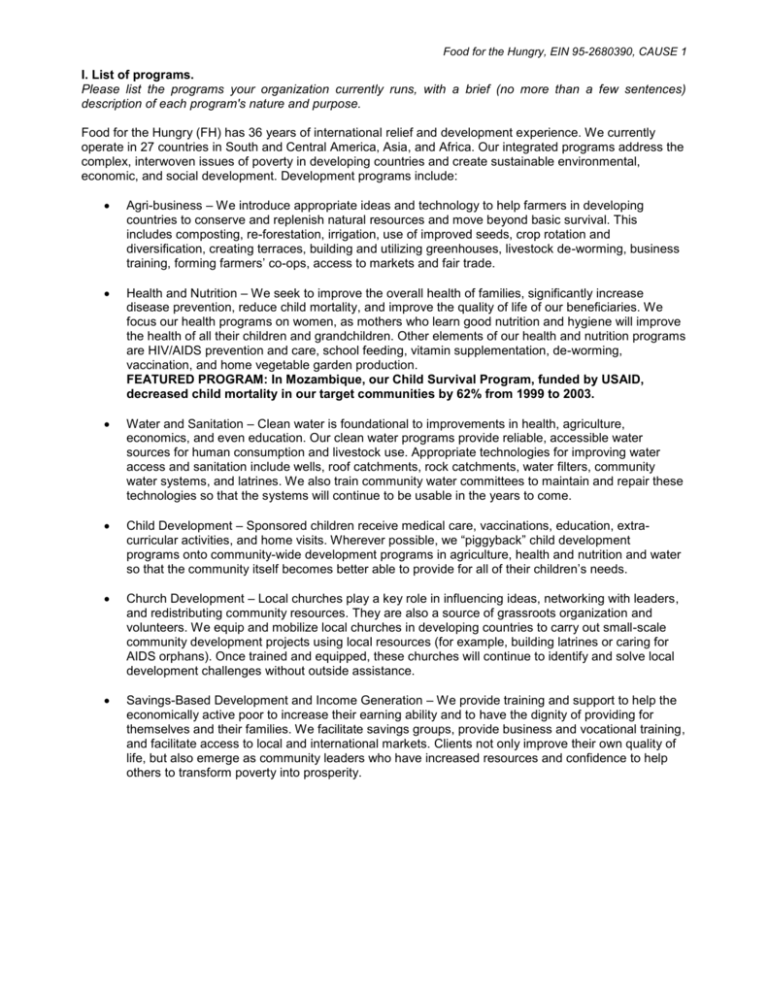
Food for the Hungry, EIN 95-2680390, CAUSE 1 I. List of programs. Please list the programs your organization currently runs, with a brief (no more than a few sentences) description of each program's nature and purpose. Food for the Hungry (FH) has 36 years of international relief and development experience. We currently operate in 27 countries in South and Central America, Asia, and Africa. Our integrated programs address the complex, interwoven issues of poverty in developing countries and create sustainable environmental, economic, and social development. Development programs include: Agri-business – We introduce appropriate ideas and technology to help farmers in developing countries to conserve and replenish natural resources and move beyond basic survival. This includes composting, re-forestation, irrigation, use of improved seeds, crop rotation and diversification, creating terraces, building and utilizing greenhouses, livestock de-worming, business training, forming farmers’ co-ops, access to markets and fair trade. Health and Nutrition – We seek to improve the overall health of families, significantly increase disease prevention, reduce child mortality, and improve the quality of life of our beneficiaries. We focus our health programs on women, as mothers who learn good nutrition and hygiene will improve the health of all their children and grandchildren. Other elements of our health and nutrition programs are HIV/AIDS prevention and care, school feeding, vitamin supplementation, de-worming, vaccination, and home vegetable garden production. FEATURED PROGRAM: In Mozambique, our Child Survival Program, funded by USAID, decreased child mortality in our target communities by 62% from 1999 to 2003. Water and Sanitation – Clean water is foundational to improvements in health, agriculture, economics, and even education. Our clean water programs provide reliable, accessible water sources for human consumption and livestock use. Appropriate technologies for improving water access and sanitation include wells, roof catchments, rock catchments, water filters, community water systems, and latrines. We also train community water committees to maintain and repair these technologies so that the systems will continue to be usable in the years to come. Child Development – Sponsored children receive medical care, vaccinations, education, extracurricular activities, and home visits. Wherever possible, we “piggyback” child development programs onto community-wide development programs in agriculture, health and nutrition and water so that the community itself becomes better able to provide for all of their children’s needs. Church Development – Local churches play a key role in influencing ideas, networking with leaders, and redistributing community resources. They are also a source of grassroots organization and volunteers. We equip and mobilize local churches in developing countries to carry out small-scale community development projects using local resources (for example, building latrines or caring for AIDS orphans). Once trained and equipped, these churches will continue to identify and solve local development challenges without outside assistance. Savings-Based Development and Income Generation – We provide training and support to help the economically active poor to increase their earning ability and to have the dignity of providing for themselves and their families. We facilitate savings groups, provide business and vocational training, and facilitate access to local and international markets. Clients not only improve their own quality of life, but also emerge as community leaders who have increased resources and confidence to help others to transform poverty into prosperity. Food for the Hungry, EIN 95-2680390, CAUSE 1 II. Program activities and budget for featured program (two pages maximum). A. Please describe the featured program, focusing on the activities that are carried out (not just the program's goals) and being as specific as possible about what problems these activities address. More than one of every five children born in Mozambique will die before their fifth birthday. Nutritional deficiencies are the underlying cause of almost 50 percent of all child deaths, while diarrhea contributes to 14 percent of deaths among under-five children1. According to 2004 surveys, Sofala province had the second highest mortality rate in the country for children under the age of five. The real tragedy of the situation is the nearly all of these children die of preventable, treatable diseases caused or aggravated by malnutrition. Food for the Hungry (FH) began working in Mozambique in 1987 and has had great success with implementing Child Survival Programs in Sofala province through the creation and implementation of community-level Care Groups. From 1998 to 2001, FH decreased malnutrition by 40% in target communities, with coinciding dramatic changes in mothers’ nutritional and health practices. A mortality study conducted in conjunction with World Relief and with the support of John Hopkins in 2004 found that, between 1999 and 2003, the under-five mortality rate dropped by 62% in areas where FH operated Care Groups. In 2005 FH expanded the Child Survival Program in the Sofala and Zambezia Provinces, covering one of the poorest regions in the country. The current expanded FH Child Survival Program (2005-2010) is poised to benefit 155,658 people by the final year of the project. FH’s Child Survival Program in Sofala and Zambezia Provinces utilizes community-level Care Groups for equipping and educating mothers to help their children survive and thrive. Care Groups connect health promoters, leader mothers, and families in order to transfer vital skills and knowledge that could mean the difference between life and death for a child. FH/Mozambique Care Group Model Each Health Promoter educates and motivates 10 Care Groups. Each Care Group has 12 Leader Mothers. Promoters Care Groups Promoter #2 Promoter #1 Promoter #3 Each Leader Mother educates and motivates pregnant women and mothers with children 0-23m of age in 14 households every two weeks. Children in households with children 24-59m are visited every six months. 12 Leader Mothers 12 Leader Mothers 12 Leader Mothers Promoter #5 Promoter #4 Promoter #6 12 Leader Mothers 12 Leader Mothers The Care Group model (see diagram) is led by 12 Leader Mothers paid Health Promoters who work with Leader 12 Leader Mothers Mothers (trusted community members elected by 12 Leader Mothers participant families) in groups of 12. The leader 12 Leader Mothers 12 Leader Mothers mothers then work with 14 families through home With this model, one Health Promoter can cover 1,680 beneficiaries. visits to educate and motivate parents to adopt healthier practices and ultimately protect their children from malnutrition and disease. Through this strategy, one Health Promoter can reach 1,680 women and children. Promoter #7 14 families 14 families 14 families 14 families 14 families 14 families 14 families 14 families 14 families 14 families 14 families 14 families Mothers involved in this program are equipped with: An understanding of the signs of disease/childhood illness and methods for prevention. Education on providing a balanced diet to children. A supply of vitamin A and iron supplements. Skills for preparing oral re-hydration solutions for children with diarrhea. Resources to connect to local health services and medication.2 The success of this project is not dependent on the long-term presence of FH in the area, but rather the long term presence of Ministry of Health offices and the community-based structure put into place during this project. Care Groups redefine the relationship between communities and the Ministry of Health, creating expectation and demand for services. Studies from FH’s previous program in Gaza, Mozambique have shown that Leader Mothers continue to meet in Care Groups long after the official program has concluded. Of the 1,457 volunteers active at the end of the project in Gaza, 1,361 (93%) were active 20 months later. Source for statistics: United Nations Children’s Fund (UNICEF), 2007. The provincial Ministry of Health offices in both Zambezia and Sofala provinces, based on FH’s program results to date, have expressed enthusiasm for FH’s Care Group program and asked FH to partner with them to extend the network of Care Groups. 1 2 Food for the Hungry, EIN 95-2680390, CAUSE 1 B. Please provide as detailed and precise a budget as possible (actual from past years, or projected for coming years) indicating how funds are spent within the program. FH / Mozambique Child Survival Project Budget, Oct. 1, 2005 - Sept 30, 2010 Year 1 (2005) Category Personnel Benefits Travel Equipment Supplies Sub-contractors Other Direct Costs USAID grant TOTAL PROGRAM COSTS Private match USAID grant Year 3 (2007) Private match USAID grant Year 4 (2008) Private match USAID grant Year 5 (2008) Private match USAID grant Private match Total Program Costs $ 123,423 $ 47,190 $ 129,594 $ 49,550 $ 199,635 $ 71,944 $ 268,406 $ 75,377 $ 280,244 $ 78,898 $ 1,324,259 $ 28,819 $ 10,382 $ 29,930 $ 10,901 $ 47,732 $ 15,028 $ 64,687 $ 15,728 $ 66,754 $ 16,445 $ 306,405 $ 49,734 $ 13,048 $ 32,551 $ 12,602 $ 64,723 $ 12,602 $ 40,806 $ 12,602 $ 33,345 $ 12,602 $ 284,614 $0 $0 $0 $0 27,998 $ 28,044 $0 $0 $0 $0 $0 $ 47,857 $ 30,889 $ 10,072 $ 4,284 $ $ 12,578 $0 $ 3,000 $0 $ $ 60,907 $ 30,011 $ 46,501 $ 16,712 $ Subtotal Direct Costs Indirect Costs Year 2 (2006) $ 323,317 $ 41,773 $365,090 140,766 $ 13,000 115,120 $ $0 $ 23,868 $ 45,575 4,158 $ 3,000 $0 $ 23,928 $0 $ 55,506 69,226 $ 96,809 $ 46,124 $ 106,340 $ 42,500 $ 630,249 $0 $ $ $0 363,511 $ 131,519 $ 251,646 $ 94,048 $ 580,976 $ 196,798 $ 501,752 $ 173,699 $ 556,186 $ 154,603 $ 2,964,544 $ 16,992 $ 32,513 $ 12,151 $ $ 64,826 $ 22,442 $ 71,859 $ 19,975 $ $284,159 $106,199 $566,578 $196,141 $628,045 $174,578 $148,512 75,062 $ $656,038 25,426 $222,224 Note to budget: The full budget is a multi-page document and is available upon request. 383,019 $3,347,564 Food for the Hungry, EIN 95-2680390, CAUSE 1 III. Monitoring and evaluation for featured program (one page maximum, except for attachments to part C). A. What is your process for monitoring the outputs of the featured program, i.e., ensuring that its activities are carried out as intended? Every two weeks during the Care Group meetings, each Leader Mother verbally reports on the status of the women and children in her group of fourteen households. This method allows for the inclusion of both literate and illiterate volunteers. The data is used by Leader Mothers and FH Health Promoters (hereafter called “Promoters”) to determine which children are at risk and which mothers need encouragement to seek certain services. At the provincial level, the aggregated data from these registers can be used to monitor progress towards meeting targets and determining problem areas. Verbal autopsy forms are filled out by Promoters for all children under two years of age who die during the project. This enables us to analyze patterns of child mortality and make midcourse changes in project strategies in order to better target interventions. Pre- and post-tests are used in all trainings of District Coordinators and Promoters, and are used to measure the quality/effectiveness of trainings and to discover where further on-the-job training is needed. Leader Mothers are orally tested on their knowledge of key project messages during their biweekly Care Group meetings in order to reinforce their current learning and assess they’re readiness to carry out health promotion without further extensive involvement of the Promoter. Quality Improvement and Verification Checklists are used by the District Coordinators in their supervision of Promoters, and by the Promoters to supervise Leader Mothers. The data from these checklists is used by FH to measure and improve the quality of key processes and interventions. The District Coordinators check the validity of the data reported by Promoters through random spot checks of growth charts of mothers in the Care Groups. They also checks the validity of oral quizes completed by the Promoters by re-testing 10 percent of groups. New Project staff are progressively trained in these monitoring tools during the project. B. What is your process for evaluating the outcomes of the featured program, i.e., investigating what ultimately happens to the people it serves? FH conducts annual Rotating Mini-Knowledge/Practice/Coverage (KPC) Surveys in project communities. For a full description of the Mini-KPC methodology, see the Title II Monitoring Toolkit produced by FH technical staff at: http://gme.fhi.net/fse/isapr/index.htm#mneToolKit. A final Knowledge/Practice/Coverage Survey will be conducted at the end of the project with 2-3 groups of 19 mothers for each the nine districts (total sample size 494). FH is training district and provincial Ministry of Health (MOH) staff in the use of Care Groups for health promotion, and the MOH has agreed to continue supervision and support of program Care Groups on a quarterly basis, once the program has ended. C. Please attach any available written reports (whether internal or by independent third parties) on both the monitoring (outputs) and evaluation (outcomes) of the featured program. Addendum A: This 2005 report, created for USAID, details FH results achieved from October 2004 to September 2005 in Mozambique. The information on Child Survival begins on page 14 (Sec 2.2). The current Child Survival project is a continuation and expansion of this program. Addendum B: Title II Monitoring Toolkit created by FH Health Program Director Tom Davis. IV. Optional: other support for featured program (one page maximum). Community-Based Solutions for Effective Malaria Control: Lessons from Mozambique, March 2005. This case study, created by World Relief, shows how the Care Group Model is an efficient and cost-effective way to reach every household in a defined geographic region with health care messages and treatment. http://www.coregroup.org/working_groups/World_Relief_Mozambique_malaria_case_study.pdf V. Confidentiality. Please be specific about any part of this application that you would like to remain confidential. This application may be made public.



